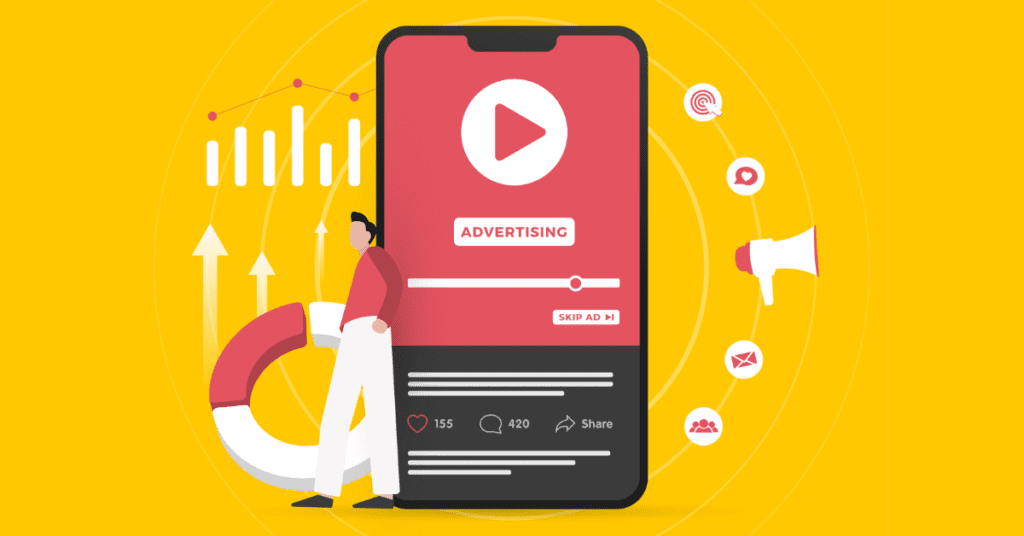If you aren’t creating video ads for mobile users then you risk missing a huge segment of your target audience.

Video is the most popular way to consume content, making it the tool of choice for marketers. Some 86 per cent of businesses use video to market their products and services — up 41 per cent since 2016. Ninety-three per cent of marketers who use video say it’s integral to their overall marketing strategy.
Now, consider this: More than 75 per cent of videos are viewed from mobile devices. It’s a big number that reflects the rise and reach of mobile computing.
According to the Pew Research Centre, 85 per cent of U.S. residents own a smartphone. This jumps to 95 per cent for millennials. In 2022, smartphones have become a necessity, with people using them to do just about everything: find directions, access reviews, watch how-to tutorials, snap photos and shop. More than half of all transactions in North America take place on mobile platforms.
How to develop a mobile video advertising strategy
- Know what you want to achieve and what your target audience will appreciate
- Tell users what you want them to do with clear CTAs
- Take bandwidth into consideration
- Keep video length short
- Optimize videos for sound off
- Make brand voice clear and consistent
The power of video advertising
In addition to providing an effective way to share information and educate potential customers about products, video ads are twice as likely to create an emotional response as static ads, according to research from the Mobile Marketing Association. This connection makes video ads more memorable and helps explain why 76 per cent of consumers and 85 per cent of millennials say they have made a purchase after watching a video ad.
Not surprisingly, 74 per cent of marketers report video has a better ROI than static images. YouTube has the best ROI for video content followed by Facebook and Instagram. And 84 per cent of video marketers say video has been effective for generating leads.
The numbers send a clear message: If you aren’t creating video advertising for mobile users you risk missing a huge segment of your target audience, many of whom are managing most aspects of their lives on their devices.
Six best practices to develop effective mobile video advertising
1. Know what you want to achieve and what your target audience will appreciate
Do you want to showcase a product or service? Do you want to highlight your brand and its values? Be clear about what you want to achieve with your mobile video advertising and set appropriate metrics to ensure you’re achieving these objectives. Whatever your goal, focus on the needs of your target audience and the type of content that will engage and maybe even inspire them. If you get it right, your mobile video ad will stand out as memorable and worthy of sharing, and help convert viewers to buyers.
2. Tell users what you want them to do
Include a call to action (CTA). This will help make it easier for your target customers to buy.
There are three places you can position your CTA:
- Before the video ad starts. This ensures viewers will see it even if they don’t get through the whole video.
- Somewhere between the start and end of the video. Ideally it should be placed during a moment when viewers are highly engaged with the video. Research shows CTAs that appear in the middle of the video ad are most likely to convert.
- At the end of the video. At this point, the viewer is invested because they’ve watched the entire video and purchase intent is high.
Tip: A clickable button in a mobile video ad works better than text to get users to take the action you want them to take.
3. Take bandwidth into account
Seamless streaming is critical to creating a positive mobile video advertising experience. Nobody wants to deal with long load times and choppy video but the ability to be mobile comes with the potential for poor reception. Optimize mobile videos for low-bandwidth connections by using the built-in options video files provide to increase speed and improve performance. Netflix uses multi-codec streaming technology to deliver high-quality video across browsers. The technology does not require a lot of bandwidth and allows the device to use the most appropriate computer program or codec for the browser it’s accessing.
Tip: Tools such as HTTP Live Stream and MPEG-DASH enable better delivery of short videos.
4. Keep videos short
Think micro to boost the likelihood that people will watch your mobile video ad to the end. Keeping the length of your videos to 15 seconds or less also makes them eligible for in-stream placements on Instagram stories and Facebook.
Fast facts:
- Instagram posts with video have 38 per cent higher engagement than posts without video.
- On Facebook, engagement for posts with video shoots up 135 per over posts that don’t include it.
Tip: All social platforms work differently. Optimize your mobile video advertising for your target audience’s social channels of choice.
5. Consider where your target audience might be when viewing your ad
Research shows more than 90 per cent of videos are viewed with the sound off on mobile. This is important to factor into how you share the information you want people to get. Audio can and should be incorporated in mobile video ads, but it should not be essential for viewers to understand the story. In other words, the message should come through loud and clear without audio and sound effects. Instead, make the visuals striking and use text or captions.
Fast fact: 80 per cent of consumers are more likely to watch an entire video when the video has captions.
6. Be authentic and make sure your brand voice is clear and consistent
Your brand identity is an important differentiator for consumers. All the elements – voice, colours, logos – should be incorporated in your mobile video ads. Content should be authentic and feel real. This will help you reinforce your brand in viewers’ minds.
Mobile video ads can help your audience find and remember you, build engagement, and convert viewers into purchasers. They should be an integral part of your marketing strategy.


